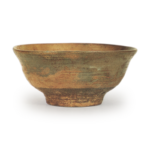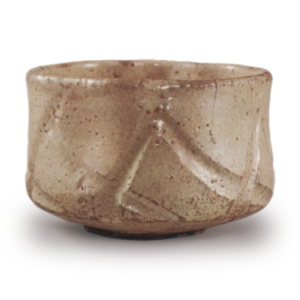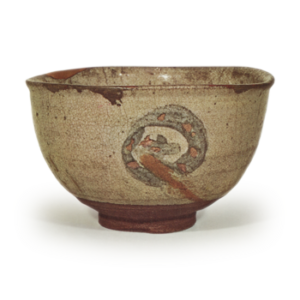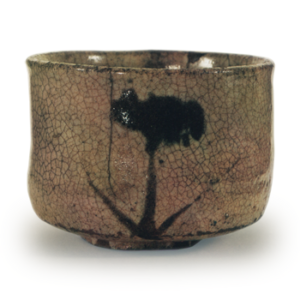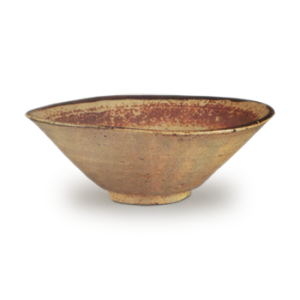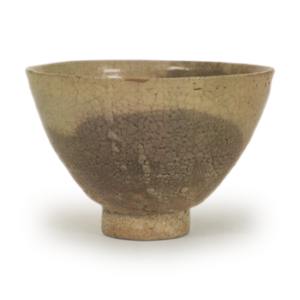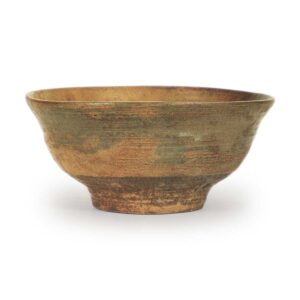
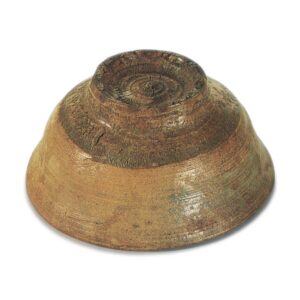
Collection: Fujita Museum of Art
Height: 6.5 – 6.7 cm
Diameter: 14.2 – 14.4 cm
Base diameter: 6.0 – 6.4 cm
Height: 1.4 cm
This is thought to be a tea bowl made by Honke Tōya. If you compare this to the tea bowl made by Honke Rikyū, the shape and dimensions are similar, but the quality and style are quite different.
The yellowish-white and grayish-blue ground colors that appear like clouds on the side of the bowl, and the extremely fine and dense lathe marks that look like threads, have led to it being given the name “Kuriun”, which means “clouds of color”.
The characteristics of the Totoya tea bowl can be said to be the following: a simple, well-formed shape made on a well-practiced potter’s wheel, a hard clay body, a thin glaze, a bright and vivid shape and color, and a beautiful change in color tone depending on the intensity of the kiln fire. Soun is perfect in that it combines all of the above conditions, and it also has a unique beauty that cannot be seen in other wares.
First of all, the shape is very distinctive. The width is large in proportion to the height, and the foot is particularly sturdy, giving the whole piece a sense of stability. Moreover, it is well-ordered and almost free of distortion, and is all wrapped in clear lines. The boldness of the foot ring’s scraping marks, in contrast to the delicate and precise lathe marks on the sides, is also exceptional. The outer wall of the foot ring is slightly knotted, but for the most part it is a large, uncurved slope, and the bold, vivid scraping that continues from the foot ring to the side, with its intense hook marks, forms the waist of the tea bowl. On the underside of the foot ring, there is even more impressive scraping. The center of the powerful whirling vortex rises in the form of a sharp helmet, and from there countless tiny cracks and fissures run out in a radial pattern. This is a phenomenon known as “doshibori” or “chirimen-jirimen”. The cracks and scorch marks on the tatami mat reinforce the effect. The beauty of the foot ring, which was created by the unexpected fusion and repulsion of clay, the potter’s wheel and the kiln fire, is reminiscent of a natural landscape.
The clay is hard and contains iron, and the glaze that covers the surface of the vessel is thin and transparent. Therefore, the clay is clearly visible through the glaze. The glaze on the side of the bowl is shiny and glossy, and the color of the base is mainly yellowish-white, then yellowish-brown, and then brownish-red, with a cloud-like pattern of grayish-blue appearing in the middle. There are tiny holes in the grayish-blue color in places, and the area around them is whitish. In contrast to the light coloring on the sides, the rough, sandy areas around the foot of the bowl have little luster and a dark brown color with a hint of yellow, which further emphasizes the rough texture of the surface. Examples of this kind of clear and large contrast in tone, from the waist line up to the base, are extremely rare, not only in the Toto-ya, but also in Korean tea bowls in general.
As you can see, the exterior is full of variety, but the interior is rather monotonous. The majority of the base color is a whitish grayish yellow, with blue cloud-like speckles and a pattern of lines, and there are two or three lines of wood turning marks. Other than that, there are only a number of circular marks on the bottom, which are said to be one of the characteristics of Totoya ware.
The origin of this tea caddy is unknown until it entered the Fujita family. The attached bag is made of Kinzan Tenbai-jofu tea cloth, and the inner box is made of paulownia wood with red joints. The lid is inscribed with the name “Toto-ya”, but the author is not sure. The outer box is lacquered in black, and the silver-powder lettering is by Nagata Shingetsu.

